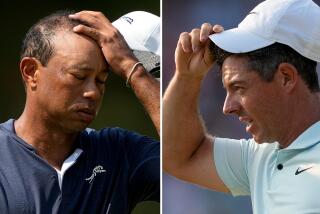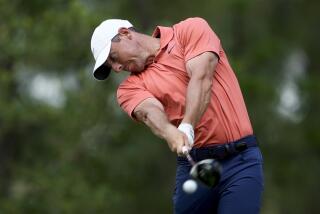Carnasty!
- Share via
CARNOUSTIE, Scotland — As expected, the opening round of the British Open was a study in the principle of aerodynamics. What happens when blustery winds collide with flying golf balls?
Well, let’s just say those golf balls were directionally challenged.
“I was never so happy to walk off a golf course in my life,” said Payne Stewart, who shot a 79 and sounded relieved about it.
Actually, Stewart should have been downright giddy about his score, because he was one of those lucky players in the 128th British Open who managed to complete the first round and still maintain a sense of humor about Carnoustie.
There wasn’t much funny stuff going on Thursday at Carnoustie, where strong, gusty winds blew par from here to the North Sea and in tandem with fairways skinnier than a 1950s tie, transformed golf’s oldest major championship into an exercise in dumb luck.
When they finally located the last truant golf ball, Rodney Pampling, a 30-year-old Australian playing his first British Open, held the first-round lead with an even-par 71.
Bernhard Langer is one shot back at one-over 72, tied with Scott Dunlap. Justin Leonard, Steve Pate, Hal Sutton, Dudley Hart, Len Mattiace, Paul Lawrie of Scotland and Mark McNulty of Zimbabwe are two shots back after beginning with a 73.
Not everyone was as fortunate. For instance, 19-year-old Spanish sensation Sergio Garcia, everyone’s superstar on training wheels, turned in an 89 that began with a triple bogey and ended when he blew off reporters waiting for him afterward.
Two hours later he had cooled off and came back to the course, explaining he wanted to be alone for two hours.
“I think it’s better to speak now that I am calm,” Garcia said. “Today is forgotten. I couldn’t do anything. Everything just came out the wrong way. Yes, I was suffering.”
Only three shots back at 74 is Tiger Woods, who braved the wind and a kiss from an unidentified female fan wearing only a bikini top, a thong and a smile. The woman ran up and kissed Woods as he stood on the 18th green.
“She gave me a hug and a quick kiss and that was about it,” Woods said.
At first glance, Woods said he was worried that the woman might not be friendly and could have been hiding something in her clothes. He quickly discarded that notion.
“Luckily, she didn’t have a whole lot on,” Woods said.
There were other adventures for Woods on Carnoustie, which he said played to about a par 75 or 76, so he was quite happy with his score.
“I shot under par . . . my par,” he said.
Colin Montgomerie, Ernie Els, Jesper Parnevik and Davis Love III are among those tied with Woods in 13-player group, but all in all, it was a very bad day for a lot of very good players.
Defending champion Mark O’Meara had an 83. Five-time champion Tom Watson, who won here in 1975, had an 82. Last week’s winner in Milwaukee, Carlos Franco of Paraguay, had an 80.
The average score was 78.31. Add it up and there were 55 players in the field of 156 who had scores in the 80s. Prayad Marksaeng, a qualifier from Thailand, had a 91. Tom Gillis, who is from Michigan but plays on the European PGA Tour, finished with a 90.
David Duval wound up with a 79 and a bad mood.
“If the average player had to play out there, he’d probably quit the game--a lot of pros too,” Duval said. “I don’t think the Open will be coming back here. The R&A; . . . I don’t know what they were trying to accomplish.”
Well, Sir Michael Bonallack of the Royal and Ancient appeared on the BBC late in the afternoon and actually apologized to the players for everything being so difficult, but it’s hard to know if Bonallack really meant it because he was smiling the whole time.
Maybe what happened Thursday is exactly what the R&A; was hoping for, although it’s doubtful.
For example, at 5:20 p.m., these were the six names listed on the leaderboard: Cooper, Pampling, Martin, Van de Velde, Lawrie and Bennett. As far as the anonymity factor goes, this group is borderline invisible. After signing his scorecard for an 82, Watson was asked how much tougher the course played in the first round than it did in 1975, when he opened with a 69.
Said Watson: “I’d say 13 shots tougher.”
It’s not exactly a secret that Carnoustie was going to be a very mean place to play since that’s all the players have been talking about this week. Even so, its degree of difficulty seemed higher than they expected.
The combination of high rough, narrow fairways, stamp-sized landing areas, rock-hard surfaces and gusty winds made conditions extremely difficult.
Watson was asked if Carnoustie was unfair.
“Unfair from the standpoint that the fairways are too narrow, but Bobby Jones said golf wasn’t meant to be a fair game,” Watson said.
Garcia said Carnoustie was not fair, and besides that, it’s also too hard.
“What I don’t understand is that people complain about the U.S. Open and they put the rough so high and the greens so hard, then you get to this Open and there is bad climate, very windy and they put the rough half a meter high and the fairways 10 meters wide,” he said. “I don’t understand it and the public doesn’t enjoy it.”
It’s pretty clear the players didn’t like it, all right. Lee Westwood shot a 76 and called his day “a slog” from start to finish.
Sutton said he felt as if he had just fought a war.
Stewart said the hardest thing he had to do was to try not to hurt himself.
Padraig Harrington came close to doing just that when he had to get on his knees to chop his ball out from between two razor-sharp gorse bushes.
Scott Gump shot an 85 and thought about finding a new career.
After the first round, nobody would blame him.
****
UNDER PAR: 0
EVEN PAR (71): 1
OVER PAR: 155
SCORES IN 70s: 99
SCORES IN 80s: 55
SCORES IN 90s: 2
ON TOP
Rodney Pampling 36-35--71 E
Bernhard Langer 35-37--72 +1
Scott Dunlap 36-36--72 +1
****
ALSO
Ernie Els 39-35--74 +3
Tiger Woods 38-36--74 +3
David Duval 39-40--79 +8
Payne Stewart 40-39--79 +8
Mark O’Meara 43-40--83 +12
FLAGGED DOWN: Mark O’Meara wants to be paid to play in the Ryder Cup. Thomas Bonk’s column. Page 6
More to Read
Go beyond the scoreboard
Get the latest on L.A.'s teams in the daily Sports Report newsletter.
You may occasionally receive promotional content from the Los Angeles Times.










